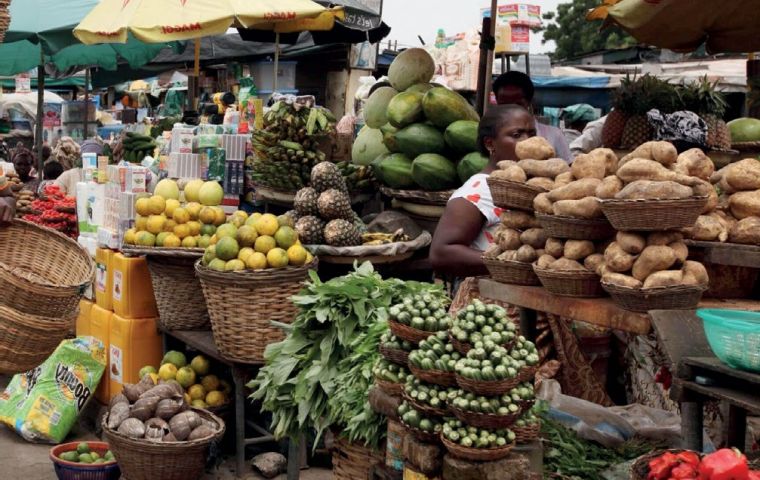MercoPress. South Atlantic News Agency
April FAO food prices index slightly higher, vegetable oils and cereals climbing
 Maize export prices increased, influenced by a robust import demand amidst mounting logistical disruptions as a result of infrastructure damages in Ukraine and concerns about Brazil's production
Maize export prices increased, influenced by a robust import demand amidst mounting logistical disruptions as a result of infrastructure damages in Ukraine and concerns about Brazil's production The benchmark for world food commodity prices edged higher in April, as higher prices of meat and modest upticks for vegetable oils and cereals outweighed decreases in sugar and dairy product prices, the Food and Agriculture Organization of the United Nations (FAO) reported.
The FAO Food Price Index, which tracks monthly changes in the international prices of a set of globally-traded food commodities, averaged 119.1 points in April, up 0.3 percent from its revised March level, while down 9.6 percent from its level a year ago.
The FAO Cereal Price Index rose by nearly 0.3 percent from March, ending a three-month declining trajectory. Global wheat export prices stabilized in April, as strong competition among major exporters offset concerns about unfavorable crop conditions in parts of the European Union, the Russian Federation and the United States of America. Maize export prices increased, influenced by a robust import demand amidst mounting logistical disruptions as a result of infrastructure damages in Ukraine and concerns about the production in Brazil ahead of the main harvest. The FAO All-Rice Price Index declined by 1.8 percent, due largely to falls in Indica quotations driven by harvest pressure.
The FAO Vegetable Oil Price Index also increased by 0.3 percent from March, reaching a 13-month high, as higher quotations for sunflower and rapeseed oil more than offset slightly lower prices for palm and soy oils.
The FAO Meat Price Index increased by 1.6 percent in April from the previous month, as international poultry, bovine and ovine meat prices all rose. By contrast, world pig meat prices fell marginally, reflecting slack internal demand in Western Europe and persistently lackluster demand from leading importers, especially China.
FAO Sugar Price Index declined by 4.4 percent from March to stand 14.7 percent below its April 2023 level. The decrease was mostly related to improved global supply prospects, notably due to larger-than-previously-anticipated outputs in India and Thailand and improved weather conditions in Brazil.
The FAO Dairy Price Index decreased marginally, by nearly 0.3 percent, ending six consecutive months of increases, led by sluggish spot import demand for skim milk powder and by lower world cheese prices impacted by the strengthening of the United States dollar. World butter prices, by contrast, increased amid steady global import demand.
FAO also released on Friday a new Cereal Supply and Demand Brief, slightly raising its forecast for the world total cereal production in 2023/24 to 2 846 million tons, a 1.2 percent increase from 2022/23. The new forecast primarily reflects revisions to rice production in Myanmar and Pakistan.
The forecast for world cereal utilization in 2023/24 was increased to 2 829 million tons, mostly reflecting higher than previously anticipated feed use of maize and barley. Global maize utilization is now expected to rise 1.6 percent over the year, that of wheat to expand by 1.9 percent while rice total utilization will likely dip mildly.
World cereal stocks are forecast to end the 2024 seasons at 890 million tons, a 2.1 percent increase from the outset of the year, pointing to a worldwide cereal stocks-to-use ratio of 30.9 percent
FAO also adjusted its forecast for global wheat production in 2024, now standing at 791 million tons, less than previously expected but still marking an increase of 0.5 percent from 2023.
For coarse grain crops, the main harvest period begins soon in southern hemisphere countries, where recent adverse weather conditions have curbed yield prospects in leading producer countries, notably Brazil and South Africa




Top Comments
Disclaimer & comment rulesCommenting for this story is now closed.
If you have a Facebook account, become a fan and comment on our Facebook Page!